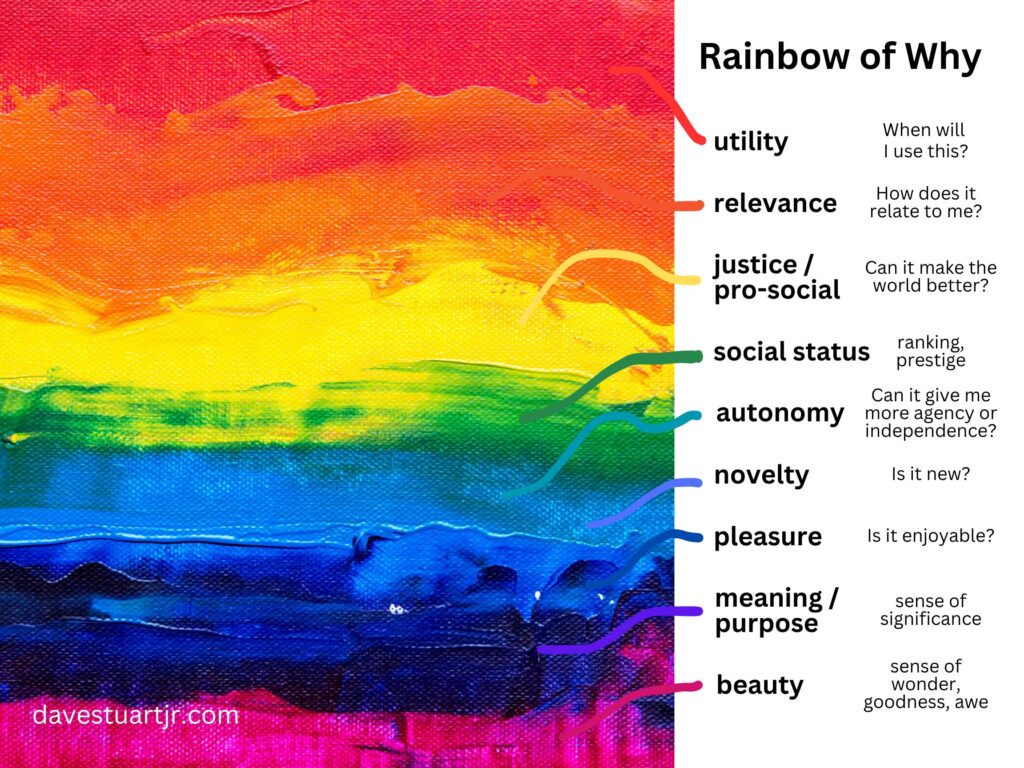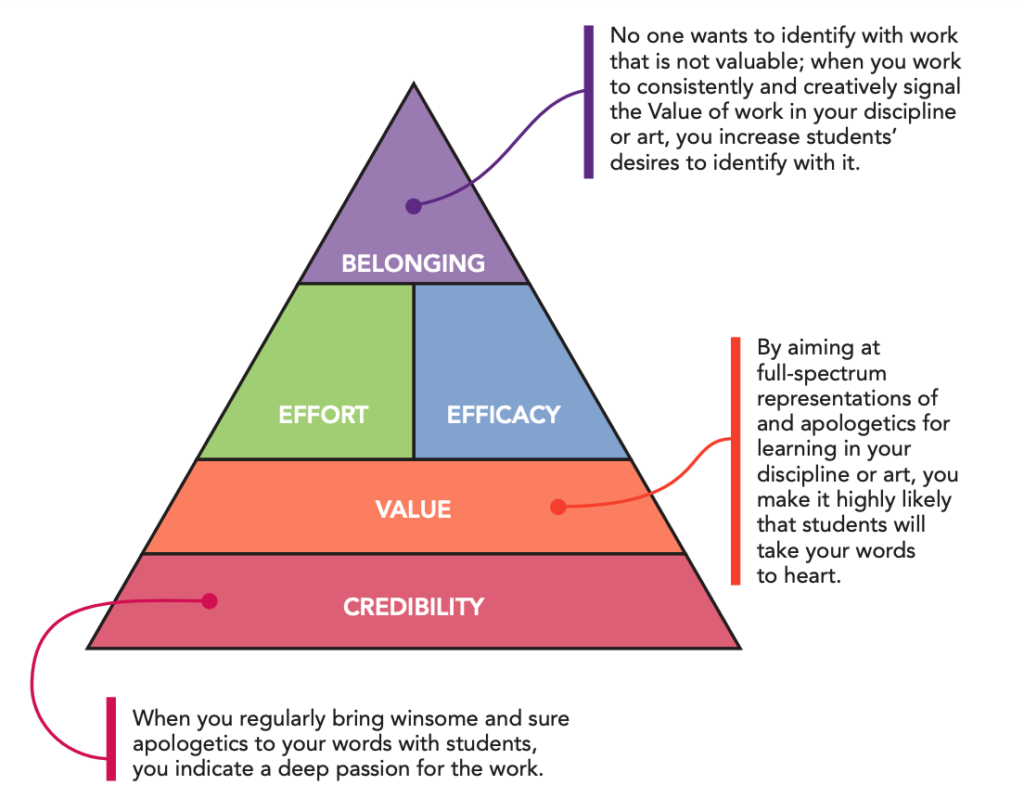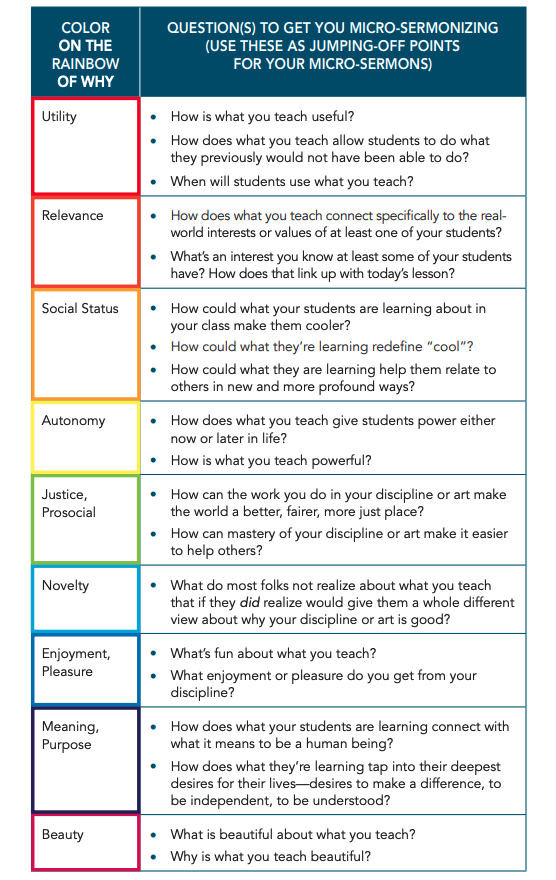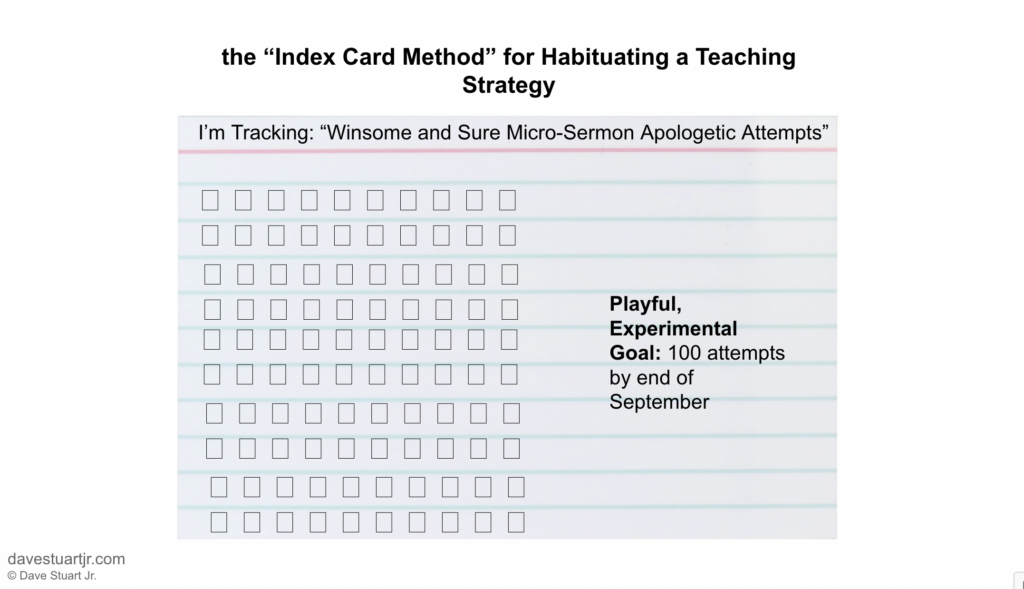In The Will to Learn: How to Cultivate Student Motivation Without Losing Your Own, I lay out an approach to student motivation in which Five Key Beliefs can be influenced using just 10 basic strategies.
The fourth of those strategies is Mini-Sermons from an Apologist Winsome and Sure.
- What is it?
- How does this strategy influence the Five Key Beliefs?
- Can you give me some examples?
- Common Questions and Hang-Ups About This Strategy
- How do I get started with mini-sermons?
- How often should I do these mini-sermons?
- What if I don't know what to say?
- How can I remind myself to give more mini-sermons?
- What if a student asks me “When will I ever use what we're learning right now?” and I can't honestly tell them they will?
- Once students get to secondary school, isn't it too late to start trying to convince them about the Value of school?
- Should mini-sermons be planned, spontaneous, or both?
What is it?
- A mini-sermon is a brief (30- to 60-second) speech in which the teacher “makes the case” for the Value of the course, the work, the learning.
- Please don't miss the mini! Many teachers (myself included) are guilty of going on inspired but extended rants about the goodness of their subjects. These are too long and too time-consuming. You'll get way better results using frequenter (yep), briefer mini-speeches than periodic extensive ones.
- An apologist is someone who makes the case for something controversial. In our case, we are making the case for the idea that learning in our class is valuable. Apologists use all kinds of angles to make their case (see Rainbow of Why below). They are people “out from whom” (apo) the meaning or reason (logos) flows, in a manner that is winsome and sure.
- Winsome, from the Old English word wyn, meaning “joy.” We want our language to emanate joy. Speaking like this is a learnable skill and a cultivatable disposition.
- Sure, from the Latin root securus, meaning “free from care.” We want our language to emanate confidence and certainty. Again, speaking like this to our students is a learnable skill and a cultivatable disposition. It won't happen magically, but if we practice it, it will happen.
The Most Important Thinking Tool for Creating Effective Mini-Sermons

I discuss this more in my Value Belief article.
Without this, you'll end up using just one or two colors, again and again. This has important side effects that sabotage the Value belief in the long term.
How does this strategy influence the Five Key Beliefs?
While mini-sermons are found in the Value chapter of The Will to Learn, they have an influence on other areas of the Five Key Beliefs pyramid as well.

Can you give me some examples?
Sure! Here's a classic one that I feature on pp. 127-130 of The Will to Learn.
(For a bunch more from Caroline, see here.)
And here's a written one, given to students as an article of the week, from Ohio educator DTR:

Common Questions and Hang-Ups About This Strategy
How do I get started with mini-sermons?
Step 1: Brainstorm. Why is the work you ask your students to do valuable? Use the following Rainbow of Why question prompts to help with this.

Step 2: Practice in private. Set your timer for 30-60 seconds. Close your classroom door. Pretend you are giving a brief, winsome, and confident speech to your students tomorrow about why the work of this lesson matters.
Step 3: Do it. Now, start doing it in front of students. Don't worry — they'll give you lots of feedback! You can use this to improve your skill, but don't let it deter you from continuing the practice.
Step 4: Repeat 100x. The more you practice mini-sermons, the better you'll get. There are some real pros out there — just check out this brief clip of our math colleague Caroline Ong in action.
How often should I do these mini-sermons?
Real simple: as often as you can. The more you give them, the better you'll get and the more likely it will become that some of your words make it into the hearts and minds of your students.
Mini-sermons are a win-win: they help us (our own teaching skills, our own teacher motivation) and that help students. Just don't forget the MINI part of mini-sermons: these things are meant to be short (30-90 seconds). Otherwise, you'll just come off as a windbag 🙂
That said: be relentless!
What if I don't know what to say?
Brainstorm with the prompts I mentioned above. If you're still stuck, put those prompts in front of your department or PLC and ask for their ideas. Beg, borrow, steal. Heck, ask ChatGPT if you need to.
Once you have some ideas, you've got to try them out. If you crash and burn during a mini-sermon, good news: it's only 30 or so seconds lost. And when you crash and burn, make note of what went wrong. Learning what doesn't work = progress.
How can I remind myself to give more mini-sermons?
I sometimes use a little index card with 100 boxes on it, like this:

What if a student asks me “When will I ever use what we're learning right now?” and I can't honestly tell them they will?
In that case, tell them they won't.
I'm serious. Look at the Rainbow of Why. There are so many more pathways to Value than utility and relevance. To drive this home, I love periodically reminding my students that they will likely never “use” what we're learning in some of our lessons. Answer student questions like this: “Maybe never. I’m not sure. But it’s still so, so, so, so good,” I tell them. “Just wait. You’ll see.” Or, “Remember during that last Pop-Up Debate when Christian made that killer argument? If we hadn't known anything about this unit we're studying, that wouldn't have been possible.”
This is what winsome and sure looks like. I'm not always going to tell you what you want to hear. But I'm always going to point your mind towards the pile of proof we're developing that learning is good even when there's no immediate and clear “real-life use case” for that learning.
I think we’d see a radical positive movement of the Value belief in our schools if we’d do more winsome and sure apologetics.
Once students get to secondary school, isn't it too late to start trying to convince them about the Value of school?
It’s true: The very best time to start inundating students with frequent, authentic, and passionate mini-sermons about the Value of learning is the day they start school as little ones and every day thereafter. The more of these kinds of signals you receive as a human being, the more likely you are to interpret them as the norm. If you’re flooded with this stuff consistently from the time you're young, you're super likely to both experience and embody a culture in which learning is deeply and beautifully and meaningfully good.
But the second best time to begin such efforts—and the only time over which you and I can exert any control—is today. For the sake of our future students, we can spread the good word that a credible teacher’s 30-second mini-sermon is never wasted time—even for the youngest of learners. But for the sake of our current students, today is the best day to get started.
Should mini-sermons be planned, spontaneous, or both?
When you're just getting started, planning them out can be really helpful. For planning, it can be as simple as WHEN in the lesson you're going to give it and WHAT you'd like to include. I just jot down a few bullet points when planning out a mini-sermon, using the Rainbow of Why brainstorming questions above.
The more you deliver planned mini-sermons, the easier you'll find it becomes to create them on the fly.
Still got questions?
If you ask a question in the comments section below, I'll answer it and incorporate your question into this article. In other words, you'll get a double whammy: you get your question answered, and you help make this article better for future readers.
Teaching right beside you,
DSJR
Leave a Reply